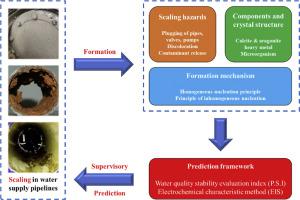Water Research ( IF 12.8 ) Pub Date : 2022-07-30 , DOI: 10.1016/j.watres.2022.118922 Chang-Geng Li 1 , Cheng Liu 2 , Wen-Hui Xu 1 , Ming-Gang Shan 1 , Hai-Xia Wu 3

|
The scaling problem in the water supply pipeline will increase the resistance coefficient of the pipeline and the pressure of the water supply pipeline, which will not only affect the operation safety of the water supply pipeline, but also cause energy waste. The scale in the pipeline will also enrich heavy metal ions and pathogenic microorganisms, affecting the safety of water supply water quality and causing secondary pollution of water quality. At present, a lot of research has been done on the composition structure and crystallization process of the scale. The study found that calcite is the main component of the scale; the scale process is a heterogeneous nucleation process induced by heavy metal particles and their corrosion products in the pipeline. The introduction of electrochemical detection technology, density functional theory and molecular dynamics simulation has greatly improved the accuracy and timeliness of water scaling conditions detection and realized the visualization of scaling mechanism. In this paper, the measurement methods of the scale in the water supply pipeline and the corresponding material composition and crystal structure characteristics are reviewed, and the mechanism of the scale and the water quality conditions are summarized. At the end of this paper, based on summarizing the existing water quality scaling tendency evaluation methods, it is proposed to establish a water quality potential scaling risk assessment framework based on Puckorius scaling index (PSI) and electrochemical impedance spectroscopy (EIS) in the future.
中文翻译:

供水管道结垢的形成机制和监督预测:综述
供水管道结垢问题会增加管道的阻力系数和供水管道的压力,不仅会影响供水管道的运行安全,还会造成能源浪费。管道内的水垢还会富集重金属离子和病原微生物,影响供水水质安全,造成水质二次污染。目前,对鳞片的组成结构和结晶过程进行了大量研究。研究发现,方解石是鳞片的主要成分;结垢过程是管道中重金属颗粒及其腐蚀产物引起的异相成核过程。引进电化学检测技术,密度泛函理论和分子动力学模拟极大地提高了水结垢条件检测的准确性和及时性,实现了结垢机理的可视化。本文综述了供水管道中水垢的测量方法及相应的材料组成和晶体结构特征,总结了水垢产生的机理和水质条件。最后,在总结现有水质结垢趋势评价方法的基础上,提出未来建立基于Puckorius结垢指数(PSI)和电化学阻抗谱(EIS)的水质潜在结垢风险评估框架。 .



























 京公网安备 11010802027423号
京公网安备 11010802027423号